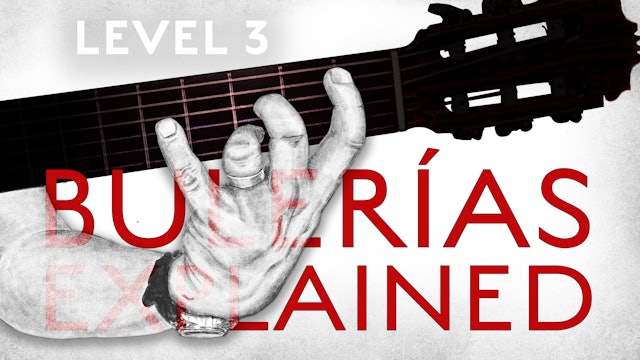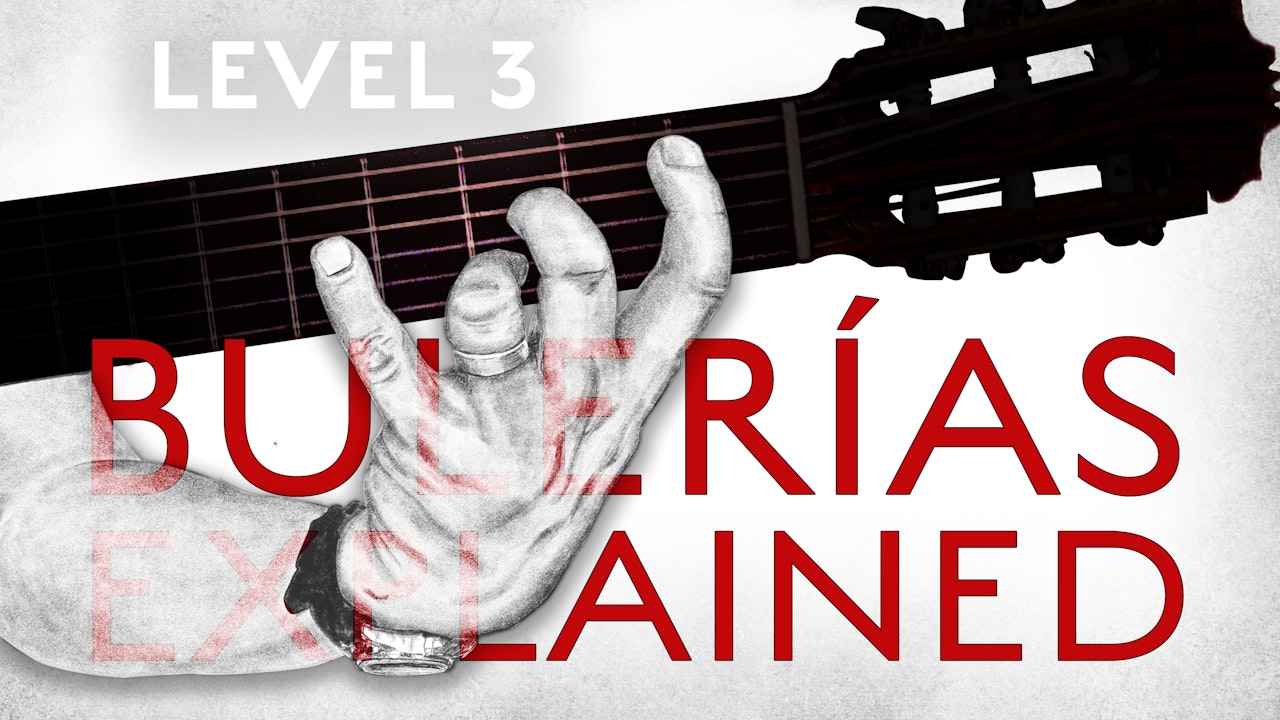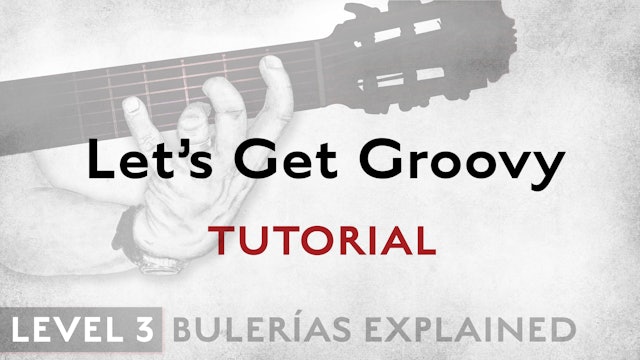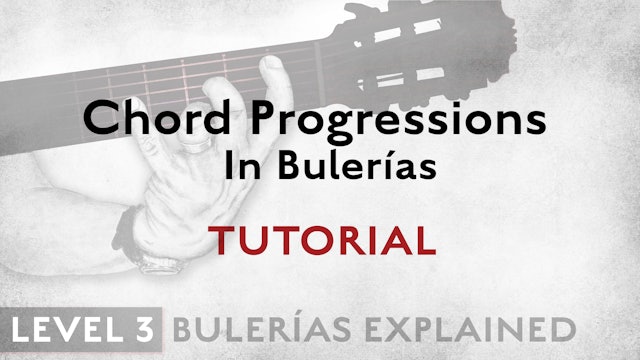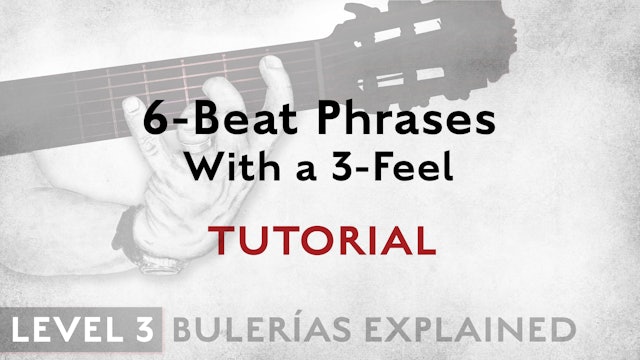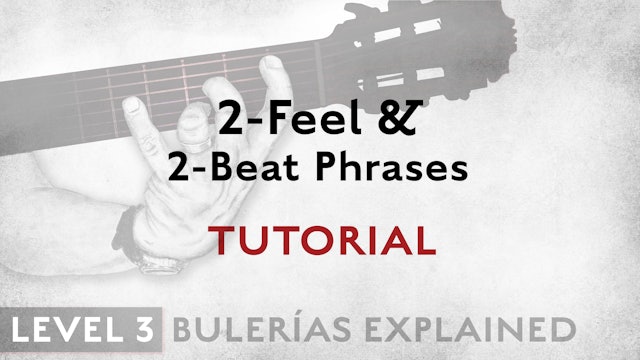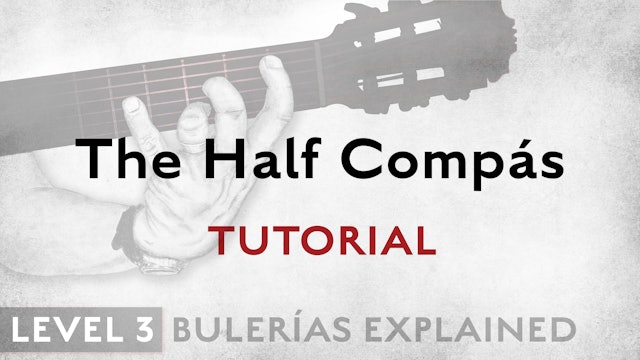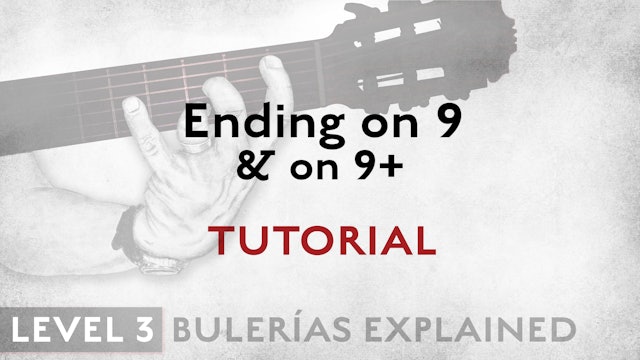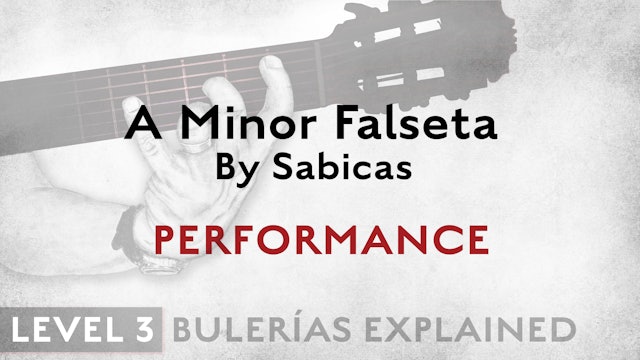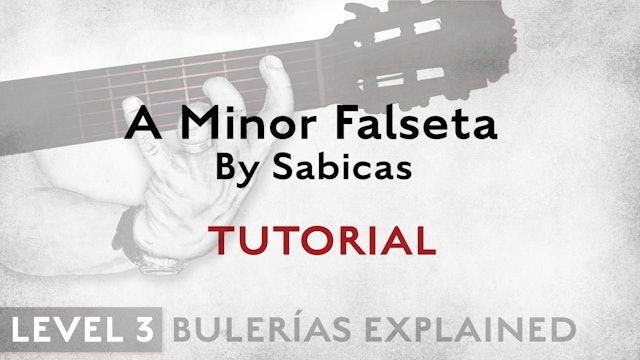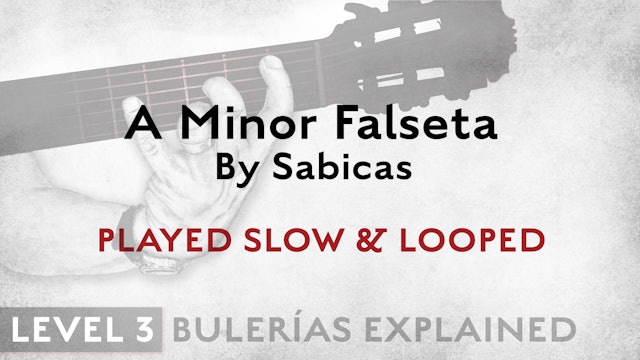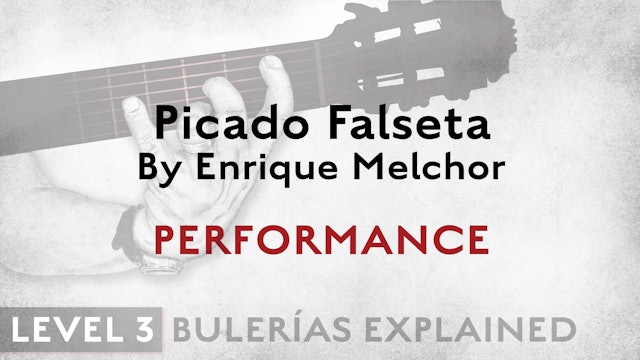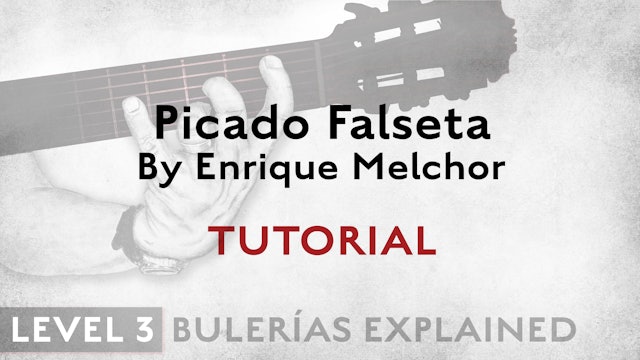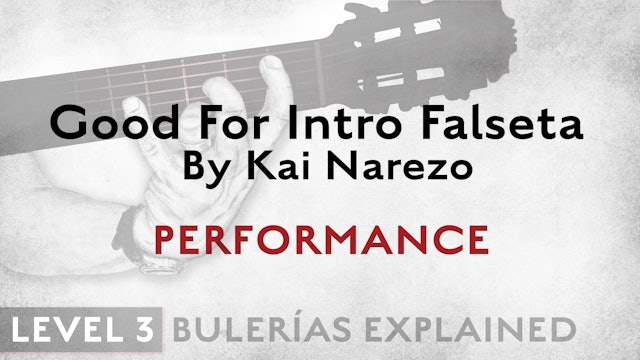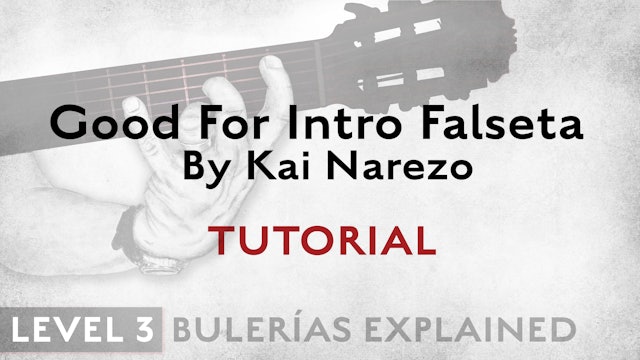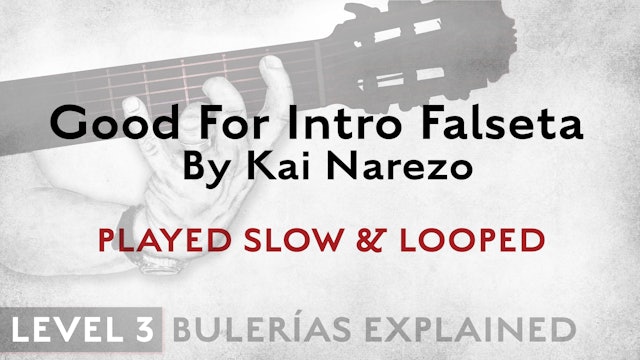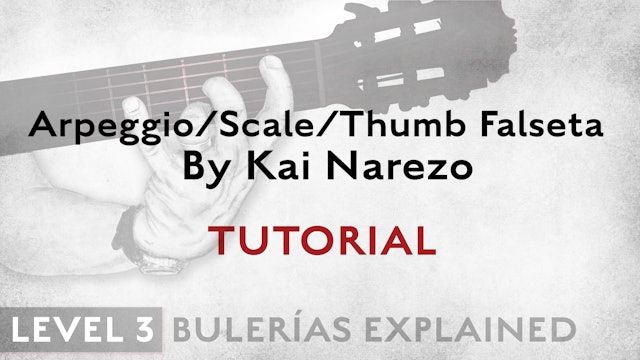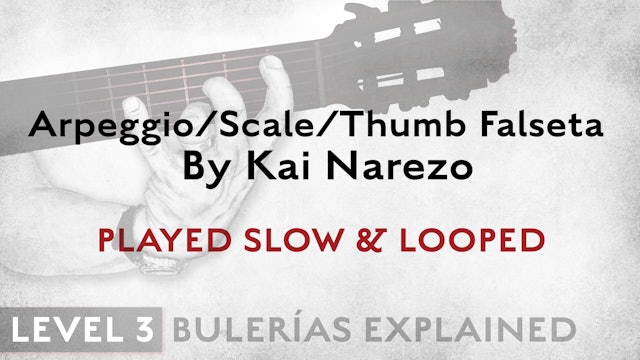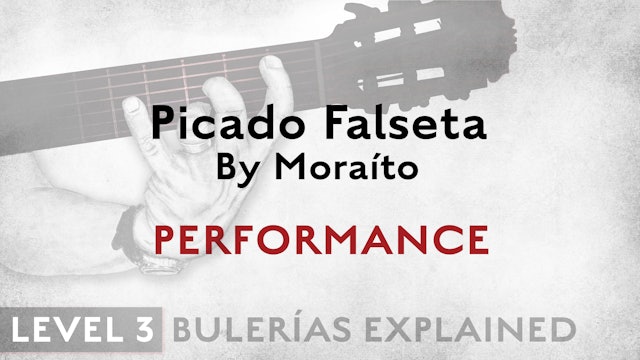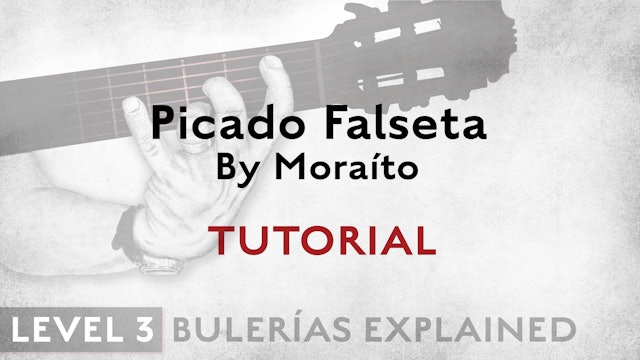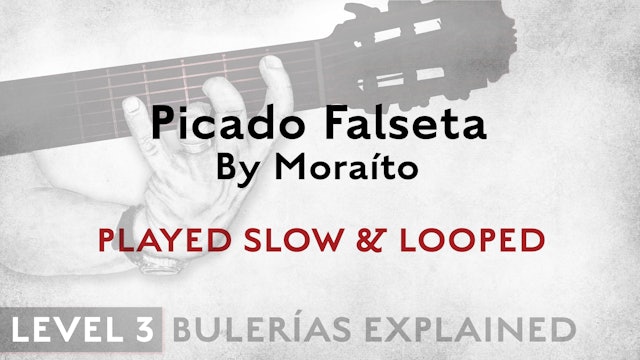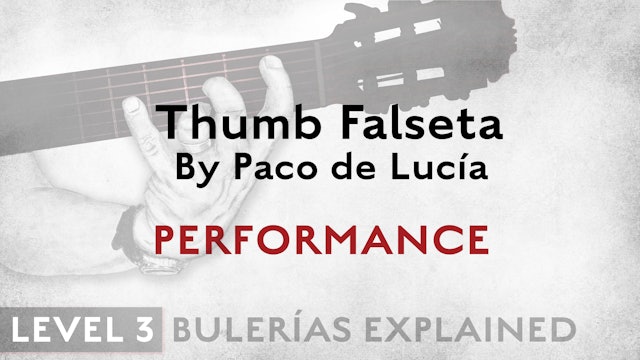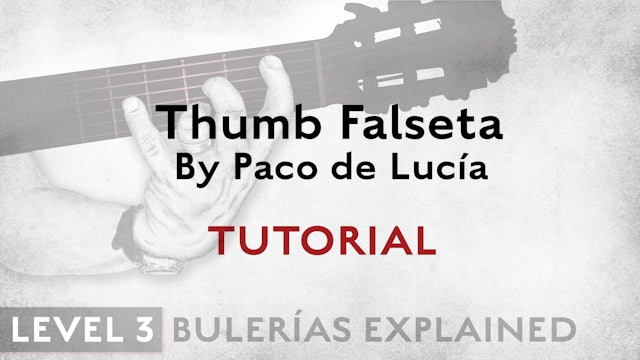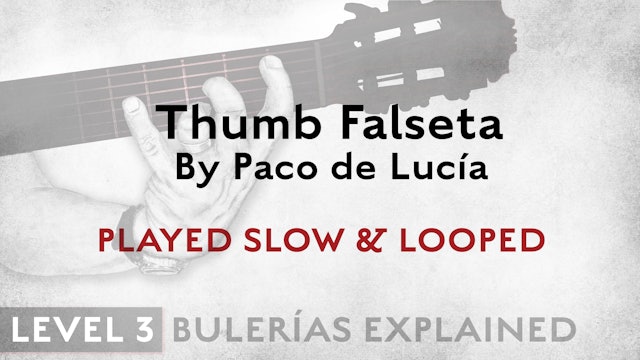Bulerías Explained LEVEL 3
31 Episodes
We highly recommend completing levels 1 & 2 before starting this level.
In this level we get into some of the advanced concepts that will allow you to really feel comfortable no matter what happens in a Buleria. By the end of Level 3 you’ll have enough material to play some real, and groovy, Bulerías.
The falsetas in this level are more complex and more technically difficult. We recommend you choose one or two at first and only add more when you are comfortable not only playing the falsetas, but getting into then and out without losing your sense of compás.
-
Bulerias Explained - Level 3 - Let's Get Groovy - TUTORIAL
Episode 1
It’s a small thing, but one that will make your Bulerías groove a lot more. If you have the Level 2 material under control, these little details are now what will make all the difference between plain compás and something a bit more interesting.
-
Bulerias Explained - Level 3 - Chord Progressions In Bulerías - TUTORIAL
Episode 2
We look at an extension of the basic Andalusian Cadence and some of the chord voicings and substitutions that we can use to vary this popular chord progression.
-
Bulerias Explained - Level 3 - 6-Beat Phrases With a 3-Feel - TUTORIAL
Episode 3
You definitely want to get used to feeling how 6-beat phrases flow in Bulerías. The good news is that your right hand already knows how to do this!
-
Bulerias Explained - Level 3 - 2-Feel & 2-Beat Phrases - TUTORIAL
Episode 4
Your right hand already knows how to do some of this, but some of it will probably be new to you. Take your time learning this, as it’s another very important way the Bulerías compás can be played.
-
Bulerias Explained - Level 3 - The Half Compás - TUTORIAL
Episode 5
The half compás can be really confusing when you first run into it. Here we introduce it in a way that will hopefully clear up some of the confusion and show you how to stay in compás even when you seem to be decidedly not in compás (strictly speaking)!
-
Bulerias Explained - Level 3 - Ending on 9 & 9+ - TUTORIAL
Episode 6
Ending on beat 9 or 9+ is one of the more common syncopations in Bulerías, but that doesn’t necessarily make it any easier. In this video we look at how to syncopate your beat 10 without losing your pulse, so that you can stay in compás.
-
Bulerias Explained - Level 3 - A Minor Falseta by Sabicas - PERFORMANCE
Episode 7
Sabicas was famous for his minor Bulerías, and this may be his most famous falseta of all. It’s almost all picado in eight notes, and the phrases start on beat 1 and 7 instead of the more common beats 12 and 6.
-
Bulerias Explained - Level 3 - A Minor Falseta by Sabicas - TUTORIAL
Episode 8
Sabicas was famous for his minor Bulerías, and this may be his most famous falseta of all. It’s almost all picado in eight notes, and the phrases start on beat 1 and 7 instead of the more common beats 12 and 6.
-
Bulerias Explained - Level 3 - A Minor Falseta by Sabicas - PLAYED SLOW & LOOPED
Episode 9
Sabicas was famous for his minor Bulerías, and this may be his most famous falseta of all. It’s almost all picado in eight notes, and the phrases start on beat 1 and 7 instead of the more common beats 12 and 6.
-
Bulerias Explained - Level 3 - Picado Falseta by Enrique Melchor - PERFORMANCE
Episode 10
This picado falseta by Enrique Melchor features both the symmetric diminished scale, which is a staple of modern flamenco, and diminished arpeggios, which are somewhat more traditional. You may find you disagree with the fingerings given, which is fine if you find an easier way for you to play th...
-
Bulerias Explained - Level 3 - Picado Falseta by Enrique Melchor - TUTORIAL
Episode 11
This picado falseta by Enrique Melchor features both the symmetric diminished scale, which is a staple of modern flamenco, and diminished arpeggios, which are somewhat more traditional. You may find you disagree with the fingerings given, which is fine if you find an easier way for you to play th...
-
Bulerias Explained - Level 3 - Picado Falseta by Enrique Melchor - SLOW & LOOPED
Episode 12
This picado falseta by Enrique Melchor features both the symmetric diminished scale, which is a staple of modern flamenco, and diminished arpeggios, which are somewhat more traditional. You may find you disagree with the fingerings given, which is fine if you find an easier way for you to play th...
-
Bulerias Explained - Level 3 - Good For Intro Falseta by Kai Narezo - PERFORM
Episode 13
This Bulerías Falseta combines arpeggio, picado, thumb and some left-hand stretches into a somewhat longer falseta than we’ve seen. It can be used as an introduction but also works anywhere else you’d play a falseta.
-
Bulerias Explained - Level 3 - Good For Intro Falseta by Kai Narezo - TUTORIAL
Episode 14
This Bulerías Falseta combines arpeggio, picado, thumb and some left-hand stretches into a somewhat longer falseta than we’ve seen. It can be used as an introduction but also works anywhere else you’d play a falseta.
-
Bulerias Explained - Level 3 - Good For Intro Falseta by Kai Narezo - SLOW/LOOP
Episode 15
This Bulerías Falseta combines arpeggio, picado, thumb and some left-hand stretches into a somewhat longer falseta than we’ve seen. It can be used as an introduction but also works anywhere else you’d play a falseta.
-
Bulerias Explained - Level 3 - ArpegScaleThumb Falseta by Kai Narezo - PERFORM
Episode 16
This Bulerías falseta starts out with a Major 7 sound (the Vicente Amigo influence) that combines arpeggio and picado, but it ends with a driving thumb figure that changes the energy of the falseta - and that can also be used on its own.
-
Bulerias Explained - Level 3 - ArpegScaleThumb Falseta by Kai Narezo - TUTORIAL
Episode 17
This Bulerías falseta starts out with a Major 7 sound (the Vicente Amigo influence) that combines arpeggio and picado, but it ends with a driving thumb figure that changes the energy of the falseta - and that can also be used on its own.
-
Bulerias Explained - Level 3 - ArpegScaleThumb Falseta by Kai Narezo - SLOW/LOOP
Episode 18
This Bulerías falseta starts out with a Major 7 sound (the Vicente Amigo influence) that combines arpeggio and picado, but it ends with a driving thumb figure that changes the energy of the falseta - and that can also be used on its own.
-
Bulerias Explained - Level 3 - Picado Falseta by Moraíto - PERFORMANCE
Episode 19
Not only is this a great-sounding Bulerías falseta, it’s also a fantastic picado burst exercise. It also features some interesting phrasing and syncopation, so stay focused!
-
Bulerias Explained - Level 3 - Picado Falseta by Moraíto - TUTORIAL
Episode 20
Not only is this a great-sounding Bulerías falseta, it’s also a fantastic picado burst exercise. It also features some interesting phrasing and syncopation, so stay focused!
-
Bulerias Explained - Level 3 - Picado Falseta by Moraíto - PLAYED SLOW & LOOPED
Episode 21
Played slower at 140bpm and looped. Not only is this a great-sounding Bulerías falseta, it’s also a fantastic picado burst exercise. It also features some interesting phrasing and syncopation, so stay focused!
-
Bulerias Explained - Level 3 - Thumb Falseta by Paco de Lucia - PERFORMANCE
Episode 22
We had to include at least on Paco de Lucia falseta in the course, and this one seems to have been one of Paco’s favorites, given how often he played it. There’s a lot going on, both rhythmically and technically, so take this one slow and make sure you understand where each phrase starts and stop...
-
Bulerias Explained - Level 3 - Thumb Falseta by Paco de Lucia - TUTORIAL
Episode 23
We had to include at least on Paco de Lucia falseta in the course, and this one seems to have been one of Paco’s favorites, given how often he played it. There’s a lot going on, both rhythmically and technically, so take this one slow and make sure you understand where each phrase starts and stop...
-
Bulerias Explained - Level 3 - Thumb Falseta by Paco de Lucia - SLOW & LOOPED
Episode 24
Played slow at 140 bpm and looped. We had to include at least on Paco de Lucia falseta in the course, and this one seems to have been one of Paco’s favorites, given how often he played it. There’s a lot going on, both rhythmically and technically, so take this one slow and make sure you understan...

